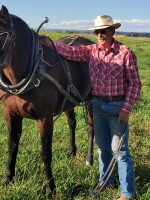When reading current agricultural publications, it’s difficult to determine whether the ag economy glass is half full or half empty. Here in the west, producers often have livestock as part of their operations, or produce feed for livestock. But a majority of farmers in other areas of the country grow grains and little else. For those producers, USDA economists have reported that net farm income, one of the key measures of profitability, is forecast at $140 billion for 2024,. That’s a $6.5 billion decline from 2023, and a sharp drop of almost 20% in net farm income from 2022 to 2023. These disheartening statistics bring back memories of the Farm Financial Crisis of the 1980s to farmers and ranchers who survived that dark period of our history. The main differences though, are that we haven’t had a Secretary of Agriculture encouraging farmers to plant from fence-row to fence-row., and today, bankers, economists and financial advisors who are looking at today’s numbers see significant differences. Freddie Barnard, professor emeritus at Purdue University, was one of the bankers who worked with farmers in the 1980s and later said: “We need to do better.” Barnard points out that prior to that crisis, a banker’s mindset was to “make the loan,” while believing that that a farmer’s real estate holdings would cover everyone involved. That false sense of security led many lenders to assume that rising real estate values and a universal conviction that farmland prices would never collapse. But collapse they did, and many farm families were forced from their land and some rural communities have never recovered from this downturn. While the ag economy may have a rough patch of road ahead, agricultural economists point out that we have a different landscape today, because ag lenders now look at 81 points of data to determine whether to approve a loan. Also, interest rates are half what they were in the 1980s. Ed Elfmann, senior vice president of agricultural and rural banking policy for the American Bankers Association, points out that lenders are looking more closely at loan applications, which protects the lender, and also helps to safeguard the farm borrower. A link to 10 timely tips to overcome the farm economy downturn is at: https://www.farmprogress.com/farm-business-planning/10-timely-tips-to-overcome-the-farm-economy-downturn
Beef processing in the U.S. is controlled by four giant companies, Cargill a global commodity trader based in Minnesota; Tyson Foods Inc., the largest meat company and chicken producer in the U.S., Brazil-based JBS SA, the world’s biggest meat packer; and National Beef Packing Co, another Brazilian owned firm. For a decade or more various agricultural organizations have attempted to sue these large corporations for alleged price fixing schemes which had impacted the price of beef cattle. So far, those suits were thrown out of court or resulted in paltry fines that these companies simply disregarded. But now a company that is the world's largest red meat buyer, that purchases two billion pounds of beef a year, which is equivalent to seven million head of cattle, is now taking on these beef barons. McDonald's is suing all four of these outfits “for allegedly conspiring for years to limit beef supplies, and boosting their profits,” while causing this fast food giant to pay artificially higher prices.
Is that a hurrah I just heard from my rancher friends?
Winston Churchill wrote, “Truth is incontrovertible, ignorance can deride it, panic may resent it, malice may destroy it, but there it is. “



